
Illustrative Math Alignment: Grade 7 Unit 7
Expressions, Equations, and Inequalities
Lesson 8: Reasoning about Solving Equations (Part 2)
Use the following Media4Math resources with this Illustrative Math lesson.
| Thumbnail Image | Title | Body | Curriculum Topic |
|---|---|---|---|
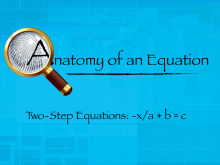
|
Video Tutorial: Anatomy of an Equation: Two-Step Equations 10 | Video Tutorial: Anatomy of an Equation: Two-Step Equations 10
TopicEquations DescriptionThis video explains solving equations with addition and division where the divisor is negative. Steps include subtracting the constant and multiplying by the negative reciprocal. Vocabulary includes negative divisor, reciprocal, and isolate. Applications focus on managing division in equations with negative values. |
Solving Two-Step Equations |
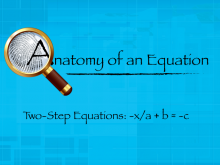
|
Video Tutorial: Anatomy of an Equation: Two-Step Equations 11 | Video Tutorial: Anatomy of an Equation: Two-Step Equations 11
TopicEquations DescriptionThis segment explains solving equations with addition and division where both the divisor and the constant are negative. Key steps include subtracting the constant and multiplying by the negative reciprocal. Vocabulary includes negative reciprocal, isolate, and simplify. Applications refine algebraic problem-solving involving multiple negatives. |
Solving Two-Step Equations |
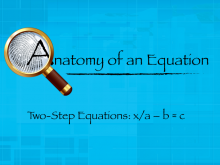
|
Video Tutorial: Anatomy of an Equation: Two-Step Equations 12 | Video Tutorial: Anatomy of an Equation: Two-Step Equations 12
TopicEquations DescriptionThis tutorial focuses on solving equations with subtraction and division. Steps include adding the constant to isolate the variable and multiplying by the reciprocal of the divisor. Vocabulary includes reciprocal, subtraction, and isolate. Applications reinforce division concepts in algebraic equations. |
Solving Two-Step Equations |
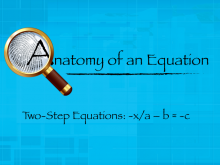
|
Video Tutorial: Anatomy of an Equation: Two-Step Equations 13 | Video Tutorial: Anatomy of an Equation: Two-Step Equations 13
TopicEquations DescriptionThis video covers equations with subtraction and division, where the divisor and the constant are negative. Techniques involve adding the constant and multiplying by the negative reciprocal. Vocabulary includes negative reciprocal, subtraction, and isolate. Applications focus on handling division with negative values in equations. |
Solving Two-Step Equations |
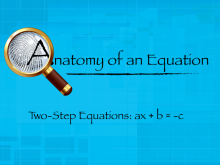
|
Video Tutorial: Anatomy of an Equation: Two-Step Equations 2 | Video Tutorial: Anatomy of an Equation: Two-Step Equations 2
TopicEquations DescriptionThis segment covers equations involving addition and multiplication where a negative number appears. It emphasizes isolating the variable by subtracting the constant, simplifying, and dividing by the coefficient. Vocabulary includes isolate, simplify, and negative numbers. Applications extend algebraic problem-solving skills with negative values. |
Solving Two-Step Equations |
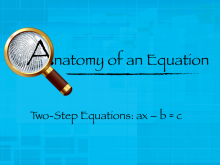
|
Video Tutorial: Anatomy of an Equation: Two-Step Equations 3 | Video Tutorial: Anatomy of an Equation: Two-Step Equations 3
TopicEquations DescriptionThis video introduces solving equations with subtraction and multiplication. Steps include adding the constant to isolate the variable and dividing by the coefficient. Vocabulary includes subtraction, isolate, and coefficient. Applications enhance understanding of balancing equations with subtraction operations. |
Solving Two-Step Equations |
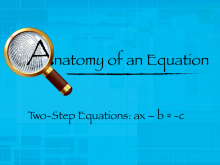
|
Video Tutorial: Anatomy of an Equation: Two-Step Equations 4 | Video Tutorial: Anatomy of an Equation: Two-Step Equations 4
TopicEquations DescriptionThis segment focuses on handling subtraction and multiplication when a negative number is involved. Techniques include adding the constant, simplifying, and dividing by a positive coefficient. Vocabulary includes subtraction, negative coefficient, and isolate. Applications involve solving equations with more complex negative value interactions. |
Solving Two-Step Equations |
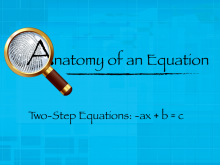
|
Video Tutorial: Anatomy of an Equation: Two-Step Equations 5 | Video Tutorial: Anatomy of an Equation: Two-Step Equations 5
TopicEquations DescriptionThis tutorial demonstrates equations with addition and negative coefficients. The process involves subtracting the constant, simplifying, and dividing by the negative coefficient. Vocabulary includes negative coefficient, simplify, and inverse operation. Applications refine algebraic methods in equations with negative variable multipliers. |
Solving Two-Step Equations |
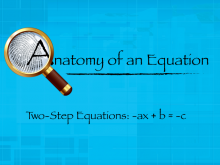
|
Video Tutorial: Anatomy of an Equation: Two-Step Equations 6 | Video Tutorial: Anatomy of an Equation: Two-Step Equations 6
TopicEquations DescriptionThis video examines equations with addition, multiplication, negative coefficients, and negative constants. It outlines steps to isolate the variable, simplify, and divide by the negative coefficient. Vocabulary includes negative constants, simplify, and isolate. Applications improve skills in handling equations with layered negative components. |
Solving Two-Step Equations |
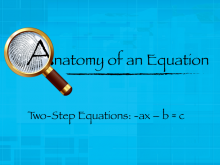
|
Video Tutorial: Anatomy of an Equation: Two-Step Equations 7 | Video Tutorial: Anatomy of an Equation: Two-Step Equations 7
TopicEquations DescriptionThis segment focuses on equations with subtraction and negative coefficients. Steps include adding the constant, simplifying, and dividing by the negative coefficient. Vocabulary includes negative coefficient, isolate, and subtraction. Applications highlight algebraic problem-solving with negative coefficients. |
Solving Two-Step Equations |
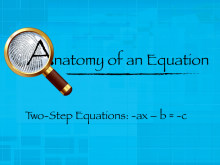
|
Video Tutorial: Anatomy of an Equation: Two-Step Equations 8 | Video Tutorial: Anatomy of an Equation: Two-Step Equations 8
TopicEquations DescriptionThis video presents subtraction, multiplication, and negative coefficients alongside negative numbers. Solving requires adding the constant, simplifying, and dividing by the negative coefficient. Vocabulary includes subtraction, negative values, and isolate. Applications stress solving equations with multiple negative components. |
Solving Two-Step Equations |
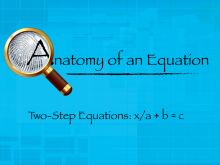
|
Video Tutorial: Anatomy of an Equation: Two-Step Equations 9 | Video Tutorial: Anatomy of an Equation: Two-Step Equations 9
TopicEquations DescriptionThis tutorial covers equations involving addition and division. Key steps are subtracting the constant and multiplying by the reciprocal of the divisor. Vocabulary includes reciprocal, division, and isolate. Applications build on foundational algebraic techniques involving division. |
Solving Two-Step Equations |

|
Video Tutorial: Equations of Parallel Lines | Video Tutorial: Equations of Parallel Lines
This video looks at the algebraic properties of equations of parallel lines. Included is a geometric proof. |
Point-Slope Form, Slope-Intercept Form and Parallel Lines |

|
Video Tutorial: Equations of Perpendicular Lines | Video Tutorial: Equations of Perpendicular Lines
This video looks at the algebraic properties of equations of perpendicular lines. Included is a geometric proof. |
Point-Slope Form, Slope-Intercept Form and Perpendicular Lines |

|
Video Tutorial: One-Step Equations: Addition | Video Tutorial: One-Step Equations: Addition
TopicSolving Equations DescriptionThis video introduces one-step equations that require one mathematical operation to solve. The focus is on addition equations, indicated by the addition symbol. The solution process involves using subtraction to isolate the variable. Key math concepts include solving equations, inverse operations, and maintaining equation balance. Key vocabulary includes addition, subtraction, equation, and inverse operation. Practical applications involve basic algebraic problem-solving. |
Solving One-Step Equations |

|
Video Tutorial: One-Step Equations: Division | Video Tutorial: One-Step Equations: Division
TopicSolving Equations DescriptionThis video covers one-step division equations, identifiable by the division symbol or fraction notation. Multiplication is applied as the inverse operation to solve for the variable. Key concepts include solving equations, inverse operations, and keeping equations balanced. Vocabulary emphasized includes division, fraction, multiplication, inverse operation, and equation. These equations are practical for solving proportional problems and foundational algebraic expressions. |
Solving One-Step Equations |
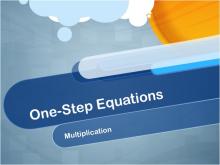
|
Video Tutorial: One-Step Equations: Multiplication | Video Tutorial: One-Step Equations: Multiplication
TopicSolving Equations DescriptionThis tutorial demonstrates solving one-step multiplication equations. Such equations are characterized by a coefficient next to the variable. Division is used to isolate the variable. The key math concepts are solving equations, using inverse operations, and maintaining balance. Important vocabulary terms include multiplication, coefficient, variable, division, and inverse operation. Applications include foundational algebra skills for understanding more complex equations. |
Solving One-Step Equations |
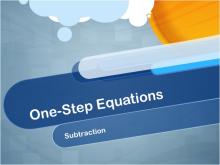
|
Video Tutorial: One-Step Equations: Subtraction | Video Tutorial: One-Step Equations: Subtraction
TopicSolving Equations DescriptionThis video explains how to solve one-step subtraction equations. These equations are identified by the subtraction symbol, and solving them involves using addition to isolate the variable. Key concepts discussed are solving equations, inverse operations, and keeping equations balanced. Important vocabulary includes subtraction, addition, inverse operation, and equation. Applications include solving simple algebra problems encountered in everyday contexts. |
Solving One-Step Equations |
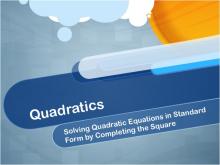
|
Video Tutorial: Quadratics, Video 7 | Video Tutorial: Quadratics, Video 7
TopicQuadratics DescriptionThis video explains completing the square to solve quadratic equations. Key terms are binomial square, roots, and simplification. It explores the width of a satellite dish, triangle dimensions, and composite figure measurements. Quadratic functions are foundational to many aspects of mathematics, from graphing parabolas to solving real-world problems involving areas and trajectories. This video is particularly relevant to understanding how these functions operate and provides practical examples to reinforce the theory. |
Graphs of Quadratic Functions and Quadratic Equations and Functions |
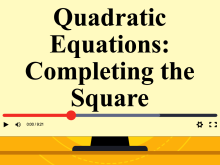
|
Video Tutorial: Solving Quadratic Equations by Completing the Square: Example 1 | This is part of a collection of video tutorials on solving quadratic equations by completing the square. Each video is a step-by-step tutorial. Note: The download is a PDF template for use in modeling the examples shown in the videos. |
Quadratic Equations and Functions |

|
Video Tutorial: Solving Quadratic Equations by Completing the Square: Example 2 | This is part of a collection of video tutorials on solving quadratic equations by completing the square. Each video is a step-by-step tutorial. Note: The download is a PDF template for use in modeling the examples shown in the videos. |
Quadratic Equations and Functions |

|
Video Tutorial: Solving Quadratic Equations by Completing the Square: Example 3 | This is part of a collection of video tutorials on solving quadratic equations by completing the square. Each video is a step-by-step tutorial. Note: The download is a PDF template for use in modeling the examples shown in the videos. |
Quadratic Equations and Functions |

|
Video Tutorial: Solving Quadratic Equations by Completing the Square: Example 4 | This is part of a collection of video tutorials on solving quadratic equations by completing the square. Each video is a step-by-step tutorial. Note: The download is a PDF template for use in modeling the examples shown in the videos. |
Quadratic Equations and Functions |
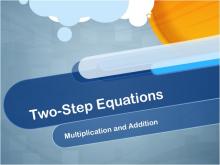
|
Video Tutorial: Two-Step Equations, Video 1 | Video Tutorial: Two-Step Equations, Video 1
TopicSolving Equations DescriptionThis video introduces solving two-step equations involving multiplication and addition. Key concepts include using inverse operations like division and subtraction to isolate the variable. Vocabulary includes variable, equation, inverse operations, multiplication, and addition. Applications include basic algebra. |
Solving Two-Step Equations |
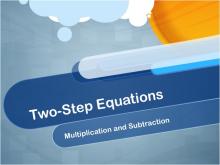
|
Video Tutorial: Two-Step Equations, Video 2 | Video Tutorial: Two-Step Equations, Video 2
TopicSolving Equations DescriptionThe video explains solving two-step equations that involve multiplication and subtraction. It emphasizes the use of inverse operations such as division and addition. Key terms are variable, equation, inverse operations, multiplication, and subtraction. Algebraic applications are highlighted. |
Solving Two-Step Equations |
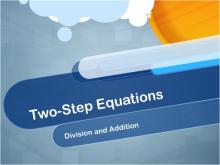
|
Video Tutorial: Two-Step Equations, Video 3 | Video Tutorial: Two-Step Equations, Video 3
TopicSolving Equations DescriptionThe tutorial covers solving two-step equations involving division and addition. It focuses on isolating the variable using inverse operations like multiplication and subtraction. Vocabulary includes variable, equation, inverse operations, division, and addition. Applications are centered on algebraic problem-solving. |
Solving Two-Step Equations |
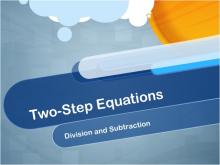
|
Video Tutorial: Two-Step Equations, Video 4 | Video Tutorial: Two-Step Equations, Video 4
TopicSolving Equations DescriptionThis video addresses solving two-step equations involving division and subtraction. It demonstrates applying inverse operations, specifically multiplication and addition, to isolate the variable. Terms such as variable, equation, inverse operations, division, and subtraction are emphasized. Algebraic uses are discussed. |
Solving Two-Step Equations |

|
Video Tutorial: What Is an Equation? | Video Tutorial: What Is an Equation?
In this video, students the basics of equations. They'll learn about true equations, false equations, and conditional equations. |
Applications of Equations and Inequalities |

|
VIDEO: Algebra Applications: Systems of Equations, 1 | VIDEO: Algebra Applications: Systems of Equations, 1
TopicSystems of Equations DescriptionDescription: Explores profit and loss through linear functions, focusing on break-even points and business profitability using TI-Nspire for visualizations. |
Applications of Linear Systems and Solving Systems of Equations |

|
VIDEO: Algebra Applications: Systems of Equations, 2 | VIDEO: Algebra Applications: Systems of Equations, 2
TopicSystems of Equations DescriptionDescription: Discusses encryption using linear systems, demonstrating substitution ciphers and matrix-based encoding for secure communication. |
Applications of Linear Systems and Solving Systems of Equations |

|
VIDEO: Algebra Applications: Systems of Equations, 3 | VIDEO: Algebra Applications: Systems of Equations, 3
TopicSystems of Equations DescriptionDescription: Analyzes ballistic missile interception through quadratic systems, graphing missile paths and their intersection as solutions to equations. |
Applications of Linear Systems and Solving Systems of Equations |
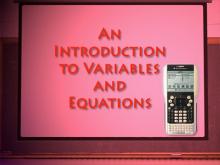
|
VIDEO: Algebra Applications: Variables and Equations, 1 | VIDEO: Algebra Applications: Variables and Equations, 1
TopicEquations DescriptionThe video introduces algebraic expressions and their ability to represent both known and unknown quantities. It defines variables as placeholders for unknowns and explains equations as relationships between two expressions. Key concepts include solving for variables and understanding the role of variables in equations. Key vocabulary includes variable, unknown quantity, and equation. The applications discussed include investigations into real-world scenarios such as honeybee populations and river geology. |
Applications of Equations and Inequalities, Variables and Unknowns and Variable Expressions |

|
VIDEO: Algebra Applications: Variables and Equations, 2 | VIDEO: Algebra Applications: Variables and Equations, 2
TopicEquations DescriptionThis segment explores the impact of colony collapse disorder on honey production using statistical data. It introduces box and whisker plots and the calculation of mean as statistical tools to analyze honey yields. Key vocabulary includes colony collapse disorder, box plot, and mean. Applications include modeling bee population declines and their broader ecological and agricultural implications. |
Applications of Equations and Inequalities, Variables and Unknowns and Variable Expressions |
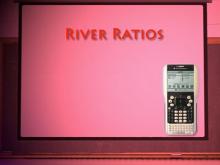
|
VIDEO: Algebra Applications: Variables and Equations, 3 | VIDEO: Algebra Applications: Variables and Equations, 3
TopicEquations DescriptionThe video investigates the geometry of river meanders using the concept of the meander ratio, calculated as the ratio of a river’s sinuous length to its straight-line length. It uses a TI-Nspire calculator to simulate river paths and compute ratios. Key vocabulary includes meander ratio, sinuous length, and geometric modeling. Applications highlight the mathematical modeling of natural phenomena and the occurrence of pi in nature. |
Applications of Equations and Inequalities, Variables and Unknowns, Variable Expressions and Applications of Ratios, Proportions, and Percents |
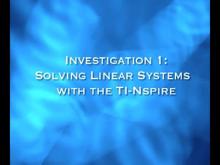
|
VIDEO: Algebra Nspirations: Solving Systems of Equations, 1 | VIDEO: Algebra Nspirations: Solving Systems of Equations, 1
TopicSystems of Equations DescriptionThis video introduces systems of equations, solving them graphically, numerically, and with TI-Nspire. Key topics include slope-intercept and standard forms, intersections of lines, and linear systems applications. Examples range from rental car cost comparisons to cell phone plans. The video emphasizes efficient problem-solving methods and practical interpretation of solutions. |
Applications of Linear Systems and Solving Systems of Equations |
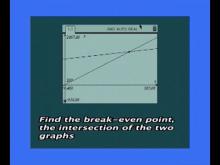
|
VIDEO: Algebra Nspirations: Solving Systems of Equations, 2 | VIDEO: Algebra Nspirations: Solving Systems of Equations, 2
TopicSystems of Equations DescriptionIn this Math Lab explore profit and loss graphs of linear functions. In this video, students will explore the core principles of Systems of Equations, developing skills to solve real-world problems effectively. The video includes demonstrations and examples to connect mathematics to everyday life. |
Applications of Linear Systems and Solving Systems of Equations |
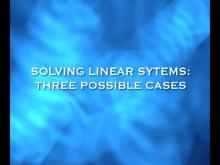
|
VIDEO: Algebra Nspirations: Solving Systems of Equations, 3 | VIDEO: Algebra Nspirations: Solving Systems of Equations, 3
TopicSystems of Equations DescriptionThe focus is on advanced methods for solving systems of equations, including nSolve and matrix row reduction (RREF). Practical examples such as ticket sales for a school play are used. Key vocabulary includes augmented matrix, consistency, and dependent systems. Applications extend to real-world decision-making and deeper algebraic understanding. |
Applications of Linear Systems and Solving Systems of Equations |
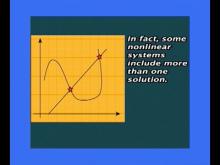
|
VIDEO: Algebra Nspirations: Solving Systems of Equations, 4 | VIDEO: Algebra Nspirations: Solving Systems of Equations, 4
TopicSystems of Equations DescriptionIn this Math Lab explore non-linear systems. In this video, students will explore the core principles of Systems of Equations, developing skills to solve real-world problems effectively. The video includes demonstrations and examples to connect mathematics to everyday life. |
Applications of Linear Systems and Solving Systems of Equations |
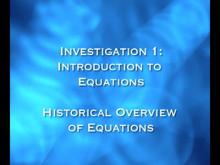
|
VIDEO: Algebra Nspirations: Variables and Equations, 1 | VIDEO: Algebra Nspirations: Variables and Equations, 1
TopicEquations DescriptionThis video covers the historical evolution of equations, the role of variables, constants, and parameters, and introduces linear and quadratic equations. Key vocabulary includes symbolic algebra, parameter, variable, and constants. Real-world applications are introduced through general problem-solving using linear equations, like solving for unknowns in financial contexts. |
Applications of Equations and Inequalities, Variables and Unknowns and Variable Expressions |
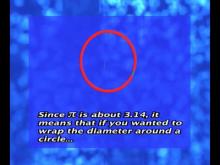
|
VIDEO: Algebra Nspirations: Variables and Equations, 2 | VIDEO: Algebra Nspirations: Variables and Equations, 2
TopicEquations DescriptionIn this Math Lab explore the linear relationship between the circumference and diameter of a circle. Relevance to the Topic: This video is a valuable resource for understanding the topic of Equations. It connects theoretical concepts with practical applications, offering insights that make learning engaging and relatable. |
Applications of Equations and Inequalities, Variables and Unknowns and Variable Expressions |
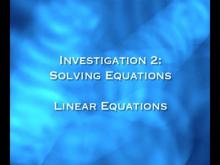
|
VIDEO: Algebra Nspirations: Variables and Equations, 3 | VIDEO: Algebra Nspirations: Variables and Equations, 3
TopicEquations DescriptionExpanding on Part 1, this video demonstrates solving linear equations algebraically and dynamically using TI-Nspire technology. Applications include walk-a-thons and bike-a-thons, illustrating linear relationships in practical contexts. Key vocabulary includes linear equation, function, and symbolic representation. |
Applications of Equations and Inequalities, Variables and Unknowns and Variable Expressions |
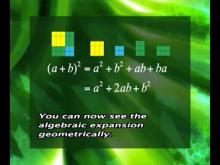
|
VIDEO: Algebra Nspirations: Variables and Equations, 4 | VIDEO: Algebra Nspirations: Variables and Equations, 4
TopicEquations DescriptionIn this Math Lab, use a visual model to find the square of a binomial. Relevance to the Topic: This video is a valuable resource for understanding the topic of Equations. It connects theoretical concepts with practical applications, offering insights that make learning engaging and relatable. |
Applications of Equations and Inequalities, Variables and Unknowns and Variable Expressions |
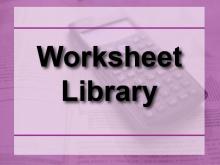
|
Worksheet: Checking Equations, Worksheet 1 | Worksheet: Checking Equations, Worksheet 1
This is part of a collection of math worksheets on the topic of determining if an equation is true or false using their addition skills. Note: Point out to students that the equals sign with a question mark above indicates that the equation may be true or false. To see the complete worksheet collection on this topic, click on this link. Note: The download is a PDF file.Related ResourcesTo see additional resources on this topic, click on the Related Resources tab.Worksheet LibraryTo see the complete collection of Worksheets, click on this link. |
Addition Facts to 25 |

|
Worksheet: Checking Equations, Worksheet 2 | Worksheet: Checking Equations, Worksheet 2
This is part of a collection of math worksheets on the topic of determining if an equation is true or false using their addition skills. Note: Point out to students that the equals sign with a question mark above indicates that the equation may be true or false. To see the complete worksheet collection on this topic, click on this link. Note: The download is a PDF file.Related ResourcesTo see additional resources on this topic, click on the Related Resources tab.Worksheet LibraryTo see the complete collection of Worksheets, click on this link. |
Addition Facts to 25 |

|
Worksheet: Checking Equations, Worksheet 3 | Worksheet: Checking Equations, Worksheet 3
This is part of a collection of math worksheets on the topic of determining if an equation is true or false using their addition skills. Note: Point out to students that the equals sign with a question mark above indicates that the equation may be true or false. To see the complete worksheet collection on this topic, click on this link. Note: The download is a PDF file.Related ResourcesTo see additional resources on this topic, click on the Related Resources tab.Worksheet LibraryTo see the complete collection of Worksheets, click on this link. |
Addition Facts to 25 |

|
Worksheet: Checking Equations, Worksheet 4 | Worksheet: Checking Equations, Worksheet 4
This is part of a collection of math worksheets on the topic of determining if an equation is true or false using their addition skills. Note: Point out to students that the equals sign with a question mark above indicates that the equation may be true or false. To see the complete worksheet collection on this topic, click on this link. Note: The download is a PDF file.Related ResourcesTo see additional resources on this topic, click on the Related Resources tab.Worksheet LibraryTo see the complete collection of Worksheets, click on this link. |
Addition Facts to 25 |

|
Worksheet: Checking Equations, Worksheet 5 | Worksheet: Checking Equations, Worksheet 5
This is part of a collection of math worksheets on the topic of determining if an equation is true or false using their addition skills. Note: Point out to students that the equals sign with a question mark above indicates that the equation may be true or false. To see the complete worksheet collection on this topic, click on this link. Note: The download is a PDF file.Related ResourcesTo see additional resources on this topic, click on the Related Resources tab.Worksheet LibraryTo see the complete collection of Worksheets, click on this link. |
Addition Facts to 25 |

|
Worksheet: Desmos Activity: Linear Equations in Point-Slope Form | Worksheet: Desmos Activity: Linear Equations in Point-Slope Form
This is part of a collection of math worksheets that are companions to interactive Desmos activities. To see the complete worksheet collection on this topic, click on this link. Note: The download is a PDF file.Related ResourcesTo see additional resources on this topic, click on the Related Resources tab.Worksheet LibraryTo see the complete collection of Worksheets, click on this link. |
Point-Slope Form |

|
Worksheet: Desmos Activity: Linear Equations in Standard Form | Worksheet: Desmos Activity: Linear Equations in Standard Form
This is part of a collection of math worksheets that are companions to interactive Desmos activities. To see the complete worksheet collection on this topic, click on this link. Note: The download is a PDF file.Related ResourcesTo see additional resources on this topic, click on the Related Resources tab.Worksheet LibraryTo see the complete collection of Worksheets, click on this link. |
Standard Form |
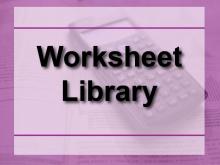
|
Worksheet: Modeling Equations | Worksheet: Modeling Equations
Given a visual model, students write the corresponding addition equation. Note: The download is a PDF file.Related ResourcesTo see additional resources on this topic, click on the Related Resources tab.Worksheet LibraryTo see the complete collection of Worksheets, click on this link. |
Addition Expressions and Equations |